The School as an Arena for Co-Creating Participation, Equity, and Well-Being—A Photovoice Study from Norway
Abstract
:1. Introduction
2. Materials and Methods
3. Results
3.1. The School
I took this picture of these three children playing on our new heap. They seem to be enjoying themselves, and I like to play there myself (…) It’s a lot of fun, you can climb, and in the wintertime, you can slide down from it.(Pupil 5)
The school had some money put aside in order to fix the old Heap there, it was just a wearied and muddy Heap that could not be used for anything (…) As we could do a lot as voluntary work, it worked very well, and the costs were lowered (…) The principal, or team leader, prepared dinner for us (once) because we all came straight from work.(Parent 1)
‘The mirror of the world” is very fun, because we have lotteries, we can go to the gym, and we can do handicrafts and make things, and it is very nice to be there (…) and there are lots of other children to play with and you never have to feel lonely, and it is so much fun to be there (…) and we meet other teachers than the usual ones and we never get as good meals as we do there.(Pupil 6)
I try to attend the school breakfast as often as possible. It’s such a nice opportunity to talk to the pupils, to get to know them in a different way and learn what interests them … this morning the conversation was all FIFA gaming (laughing). As I am mostly stuck in my office during the day, I appreciate this opportunity to be close with the pupils, and sometimes the parents if they are joining, and when I see that the children are happy, it makes me feel happy… it creates well-being!(School employee 4)
It’s not exactly a nine to five job, not an eight to six job either (…) But if the pupils experience well-being during the school day, then it will influence their leisure time. And if they experience well-being at the school during leisure time, they will bring that feeling into the classroom the next day.(School employee 3)
I believe the people working at the school are the most important resource. I mean you can have all the money in the world, you could have the most impressive building, or you could have a cardboard box. At the end of the day, it is the people in the organization or in the house who create the feeling of safety and inclusion … the belongingness.(Parent 4)
3.2. Safety
And on this picture, you can see the school traffic patrol, and they stop the traffic so that the small pupils can cross the road safely … and you feel safe … because even if the cars drive fast, the patrol ensures that they slow down (…) I think the school patrol creates well-being because it make us feel safe.(Pupil 1)
Already many, many years ago I decided that those who walk into this school … inside this school, everybody should experience well-being (here). No matter how your life is on the outside (…) being in here it should feel good. In this school it will be acceptance, you will be accepted. You shall feel safe!(School employee, 6)
3.3. Inclusion
Today we had the four-year control, and the children come with their parents, so we get a chance to talk to the parents, to connect with them (…) In this school we meet children from so many cultures and with different “baggage”… after all, we are situated in this neighborhood which has its challenges… so we meet a lot of children that we know we really mean a lot for… we often get to know that we made a difference, right? And to know that you really made a difference, that’s just so valuable.(School employee 6)
Usually, the whole class is included and the classes are big … many families live in small flats in our community so it’s easier to gather at school, and you can use the sport facilities, and other facilities and the kitchen if you want to cook something. So, it’s really practical (…) It’s kind of ensuring equity really, because everybody gets the possibility to have a party, or at least given the opportunity to make it happen.(Parent 3)
And at the café everybody brings food, and there are dishes from all around the world, and the children are so proud to present candy from Poland, or cakes from Norway or wherever … and when sitting around the table with the other families you realize that we are all the same, we are all part of this community.(Parent 4)
3.4. Cohesion
We (the school) want to be a place where everybody can meet. Where everyone is equally important. We strive to create a ‘we-culture’ at the school and in the community.(School employee 3)
I think the reason why we so much like being here, is that we have classes, but then we have things to do after classes at the school in the evening, and that’s why I like it so much here, because we always have all our friends right here.(Pupil, 1)
On the soccer field parents are often playing with the kids, and I think it creates a great sense of cohesion because the children get to know each other’s parents. It’s a small community and the children know us, like when you approach the school someone will shout: “there comes your mum to pick you up!”. So, it’s a very nice gathering place. If there is nobody home to play with in your street, you could always ride your bike to the school to find somebody to play football with, so it’s definitely the gathering place for the community.(Parent 1)
And this is a picture of the statue of Arnardo right outside the school. That’s kind of illustrative of this community. He came from here, from nowhere, and then became the king of Circus in Norway, and we are so proud of him. And there you see the bench where old people sit and chat. And there is the playground of the old kindergarten, and then there is the school (…) and the bushes by the statue are super exciting for the small children to play in … so all of this in a way represents how important the school is in this community, connecting everybody and making us feel that we belong together. After all, the node of our community is the school, it’s like a little nerve center.(Parent 4)
4. Discussion
5. Conclusions
Author Contributions
Funding
Institutional Review Board Statement
Informed Consent Statement
Data Availability Statement
Acknowledgments
Conflicts of Interest
References
- WHO. Ottawa Charter for Health Promotion; WHO: Ottawa, ON, Canada, 1986. [Google Scholar]
- WHO. Copenhagen Consensus of Mayors. Healthier and Happier Cities for All. A Transformative Approach for Safe, Inclusive, Sustainable and Resilient Societies; WHO Reginal Office for Europe: Copenhagen, Denmark, 2018. [Google Scholar]
- Weare, K. Promoting Mental, Emotional and Social Health: A Whole School Approach; Routledge: London, UK, 2000. [Google Scholar]
- Arntzen, A.; Boe, T.; Dahl, E.; Drange, N.; Eikemo, T.A.; Elstad, J.I.; Fosse, E.; Krokstad, S.; Syse, A.; Sletten, M.A.; et al. 29 recommendations to combat social inequalities in health. The Norwegian Council on Social Inequalities in Health. Scand. J. Public Health 2019, 47, 598–605. [Google Scholar] [CrossRef] [PubMed]
- Ministry of Health and Care Services. Folkehelsemeldinga. Gode Liv i Eit Trygt Samfunn; Stortingsmelding 19: Oslo, Norway, 2019. [Google Scholar]
- Weber, E.R.; Khademian, A.M. Wicked problems, knowledge challenges, and collaborative capacity builders in network settings. Public Admin. Rev. 2008, 68, 334–349. [Google Scholar] [CrossRef]
- Clift, S.; Jensen, B.B. The Health Promoting School: International Advances in Theory, Evaluation and Practice; Danish University of Education Press: Copenhagen, Denmark, 2005. [Google Scholar]
- Lewallen, T.C.; Hunt, H.; Potts-Datema, W.; Zaza, S.; Giles, W. The Whole School, Whole Community, Whole Child Model: A New Approach for Improving Educational Attainment and Healthy Development for Students. J. Sch. Health 2015, 85, 729–739. [Google Scholar] [CrossRef] [Green Version]
- Goldberg, J.M.; Sklad, M.; Elfrink, T.R.; Schreurs, K.M.G.; Bohlmeijer, E.T.; Clarke, A.M. Effectiveness of interventions adopting a whole school approach to enhancing social and emotional development: A meta-analysis. Eur. J. Psychol. Educ. 2019, 34, 755–782. [Google Scholar] [CrossRef] [Green Version]
- Rowe, F.; Stewart, D. Promoting connectedness through whole-school approaches: A qualitative study. Health Educ. 2009, 109, 396–413. [Google Scholar] [CrossRef] [Green Version]
- Willgerodt, M.A.; Walsh, E.; Maloy, C. A Scoping Review of the Whole School, Whole Community, Whole Child Model. J. Sch. Nurs. 2021, 37, 61–68. [Google Scholar] [CrossRef]
- Langford, R.; Bonell, C.P.; Jones, H.E.; Pouliou, T.; Murphy, S.M.; Waters, E.; Komro, K.A.; Gibbs, L.F.; Magnus, D.; Campbell, R. The WHO Health Promoting School framework for improving the health and well-being of students and their academic achievement. Cochrane Database Syst. Rev. 2014. [Google Scholar] [CrossRef] [PubMed]
- McMullen, J.M.; George, M.; Ingman, B.C.; Pulling Kuhn, A.; Graham, D.J.; Carson, R.L. A Systematic Review of Community Engagement Outcomes Research in School-Based Health Interventions. J. Sch. Health 2020, 90, 985–994. [Google Scholar] [CrossRef] [PubMed]
- Diamond, C.; Freudenberg, N. Community Schools: A Public Health Opportunity to Reverse Urban Cycles of Disadvantage. J. Urban Health 2016, 93, 923–939. [Google Scholar] [CrossRef] [Green Version]
- Fitzgerald, A.M.; Quiñones, S. Working in and With Community: Leading for Partnerships in a Community School. Leadersh. Policy Sch. 2019, 18, 511–532. [Google Scholar] [CrossRef]
- Galindo, C.; Sanders, M.; Abel, Y. Transforming Educational Experiences in Low-Income Communities. Am. Educ. Res. J. 2017, 54, 140S–163S. [Google Scholar] [CrossRef]
- Islam, M.K.; Merlo, J.; Kawachi, I.; Lindstrom, M.; Gerdtham, U.G. Social capital and health: Does egalitarianism matter? A literature review. Int. J. Equity Health 2006, 5, 3. [Google Scholar] [CrossRef] [Green Version]
- Ehsan, A.; Klaas, H.S.; Bastianen, A.; Spini, D. Social capital and health: A systematic review of systematic reviews. SSM Popul. Health 2019, 8, 100425. [Google Scholar] [CrossRef]
- Hoogerbrugge, M.M.; Burger, M.J. Neighborhood-Based social capital and life satisfaction: The case of Rotterdam, The Netherlands. Urban Geogr. 2018, 39, 1484–1509. [Google Scholar] [CrossRef] [Green Version]
- Uphoff, E.P.; Pickett, K.E.; Cabieses, B.; Small, N.; Wright, J. A systematic review of the relationships between social capital and socioeconomic inequalities in health: A contribution to understanding the psychosocial pathway of health inequalities. Int. J. Equity Health 2013, 12, 54. [Google Scholar] [CrossRef] [Green Version]
- McKnight, J.L.; Kretzmann, J.P. Mapping community capacity. In Community Organizing and Community Building for Health and Welfare, 3rd ed.; Minkler, M., Ed.; Ruthers University Press: New Brunswick, NJ, USA, 2012. [Google Scholar]
- Guribye, E. Co-creation of Linking Social Capital in ‘Municipality 3.0’. J. Civ. Soc. 2018, 14, 77–93. [Google Scholar] [CrossRef]
- Osborne, S.P. From public service-dominant logic to public service logic: Are public service organizations capable of co-production and value co-creation? Public Manag. Rev. 2018, 20, 225–231. [Google Scholar] [CrossRef] [Green Version]
- Von Heimburg, D.; Ness, O. Relational welfare: A socially just response to co-creating health and wellbeing for all. Scand. J. Public Health 2020. [Google Scholar] [CrossRef] [PubMed]
- Voorberg, W.H.; Bekkers, V.J.J.M.; Tummers, L.G. A Systematic Review of Co-Creation and Co-Production: Embarking on the social innovation journey. Public Manag. Rev. 2015, 17, 1333–1357. [Google Scholar] [CrossRef] [Green Version]
- Torfing, J.; Sørensen, E.; Røiseland, A. Transforming the Public Sector Into an Arena for Co-Creation: Barriers, Drivers, Benefits, and Ways Forward. Adm. Soc. 2019, 51, 795–825. [Google Scholar] [CrossRef]
- Von Heimburg, D.; Cluley, V. Advancing complexity-informed health promotion: A scoping review to link health promotion and co-creation. Health Promot. Int. 2020, 36, 581–600. [Google Scholar] [CrossRef] [PubMed]
- Østfoldhelsa. Vil Slippe Nærmiljøene Inn På Skolene. Available online: https://ostfoldhelsa.no/ukategorisert/vil-slippe-naermiljoene-inn-pa-skolene/ (accessed on 1 June 2021).
- Kinge, J.M.; Sælensminde, K.; Dieleman, J.; Vollset, S.E.; Norheim, O.F. Economic losses and burden of disease by medical conditions in Norway. Health Policy 2017, 121, 691–698. [Google Scholar] [CrossRef] [PubMed]
- Kinge, J.M.; Modalsli, J.H.; Overland, S.; Gjessing, H.K.; Tollanes, M.C.; Knudsen, A.K.; Skirbekk, V.; Strand, B.H.; Haberg, S.E.; Vollset, S.E. Association of Household Income With Life Expectancy and Cause-Specific Mortality in Norway, 2005–2015. J. Am. Med. Assoc. 2019, 321, 1916–1925. [Google Scholar] [CrossRef] [PubMed]
- Østfold County. Oss i Østfold 2019. Befolkningskartlegging; Østfold County: Østfold, Norway, 2019; p. 138. [Google Scholar]
- Dahl, E.; Bergsli, H.; van der Wel, K. Sosial Ulikhet i Helse: En Norsk Kunnskapsoversikt; Oslo and Akershus University College: Oslo, Norway, 2014. [Google Scholar]
- Rosbach, H.M. Alvimhaugen Nærmiljøhus. Rapport Om Nærmiljøhusets Betydning for Beboere På Alvim i Et Helsefremmende Perspektiv; Sarpsborg municipality: Sarpsborg, Norway, 2018. [Google Scholar]
- Wang, C.; Burris, M.A. Photovoice: Concept, Methodology, and Use for Participatory Needs Assessment. Health Educ. Behav. 1997, 24, 369–387. [Google Scholar] [CrossRef] [PubMed] [Green Version]
- Nayar, S.; Stanley, M. Qualitative Research Methodologies for Occupational Science and Therapy; Routledge: Oxon, UK, 2015. [Google Scholar]
- Catalani, C.; Minkler, M. Photovoice: A Review of the Literature in Health and Public Health. Health Educ. Behav. 2010, 37, 424–451. [Google Scholar] [CrossRef]
- Malterud, K. Kvalitative Forskningsmetoder for Medisin Og Helsefag; Universitetsforlaget: Oslo, Norway, 2017; p. 254. [Google Scholar]
- Wang, C. Youth Participation in Photovoice as a Strategy for Community Change. J. Community Pract. 2006, 14, 147–161. [Google Scholar] [CrossRef]
- Malterud, K. Systematic text condensation: A strategy for qualitative analysis. Scand. J. Public Health 2012, 40, 795–805. [Google Scholar] [CrossRef] [PubMed]
- Drew, S.; Guillemin, M. From photographs to findings: Visual meaning-making and interpretive engagement in the analysis of participant-generated images. Vis. Stud. 2014, 29, 54–67. [Google Scholar] [CrossRef]
- Moore, T.H.M.; Kesten, J.M.; López-López, J.A.; Ijaz, S.; McAleenan, A.; Richards, A.; Gray, S.; Savović, J.; Audrey, S. The effects of changes to the built environment on the mental health and well-being of adults: Systematic review. Health Place 2018, 53, 237–257. [Google Scholar] [CrossRef]
- Altomonte, S.; Allen, J.; Bluyssen, P.M.; Brager, G.; Heschong, L.; Loder, A.; Schiavon, S.; Veitch, J.A.; Wang, L.; Wargocki, P. Ten questions concerning well-being in the built environment. Build. Environ. 2020, 180, 106949. [Google Scholar] [CrossRef]
- Zhu, Y. Toward community engagement: Can the built environment help? Grassroots participation and communal space in Chinese urban communities. Habitat Int. 2015, 46, 44–53. [Google Scholar] [CrossRef] [Green Version]
- Mazumdar, S.; Learnihan, V.; Cochrane, T.; Davey, R. The Built Environment and Social Capital: A Systematic Review. Environ. Behav. 2018, 50, 119–158. [Google Scholar] [CrossRef]
- Hwang, E.; Brossoie, N.; Jeong, J.W.; Song, K. The Impacts of the Neighborhood Built Environment on Social Capital for Middle-Aged and Elderly Koreans. Sustainability 2021, 13, 756. [Google Scholar] [CrossRef]
- Wickes, R.; Zahnow, R.; Corcoran, J.; Hipp, J.R. Neighbourhood social conduits and resident social cohesion. Urban Stud. 2019, 56, 226–248. [Google Scholar] [CrossRef]
- Maier, A.; Daniel, J.; Oakes, J.; Lam, L. Community Schools as an Effective School Improvement Strategy: A Review of the Evidence; Learning Policy Institute: Palo Alto, CA, USA, 2017. [Google Scholar]
- Feldman, A.F.; Matjasko, J.L. The Role of School-Based Extracurricular Activities in Adolescent Development: A Comprehensive Review and Future Directions. Rev. Educ. Res. 2005, 75, 159–210. [Google Scholar] [CrossRef]
- Sanders, M.G.; Harvey, A. Beyond the school walls: A case study of principal leadership for school-community collaboration. Teach. Coll. Rec. 2002, 104, 1345–1368. [Google Scholar] [CrossRef]
- Lester, L.; Cefai, C.; Cavioni, V.; Barnes, A.; Cross, D. A Whole-School Approach to Promoting Staff Wellbeing. Aust. J. Teach. Educ. 2020, 45, 1–22. [Google Scholar] [CrossRef]
- Warne, M.; Snyder, K.; Gillander Gådin, K. Promoting an Equal and Healthy Environment. Qual. Health Res. 2013, 23, 1354–1368. [Google Scholar] [CrossRef] [PubMed]
- Wahab, S.N.B.A.; Mordiffi, S.Z.; Ang, E.; Lopez, V. Light at the end of the tunnel: New graduate nurses’ accounts of resilience: A qualitative study using Photovoice. Nurse Educ. Today 2017, 52, 43–49. [Google Scholar] [CrossRef]
- Malterud, K.; Siersma, V.D.; Guassora, A.D. Sample Size in Qualitative Interview Studies: Guided by Information Power. Qual. Health Res. 2016, 26, 1753–1760. [Google Scholar] [CrossRef]
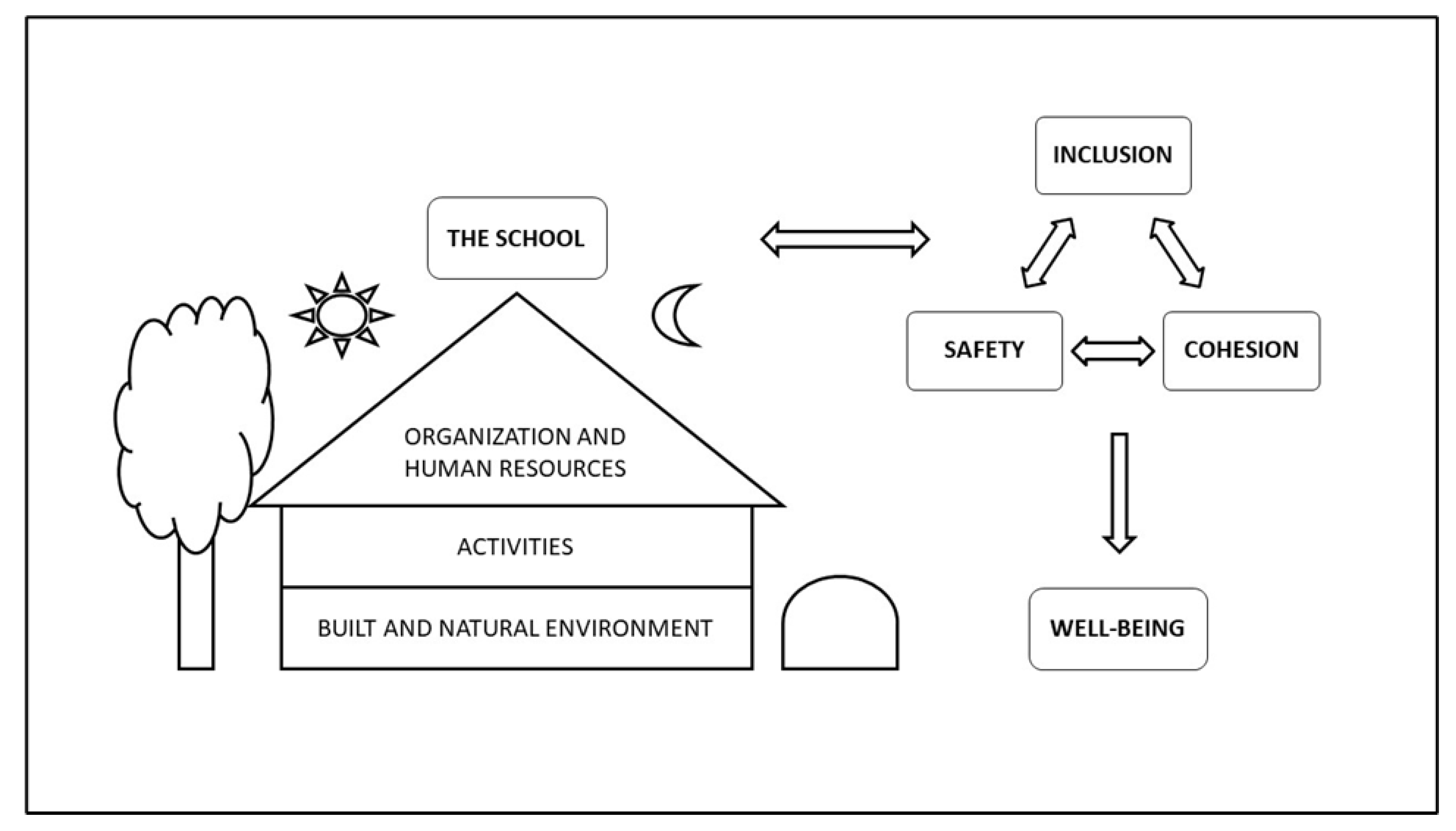
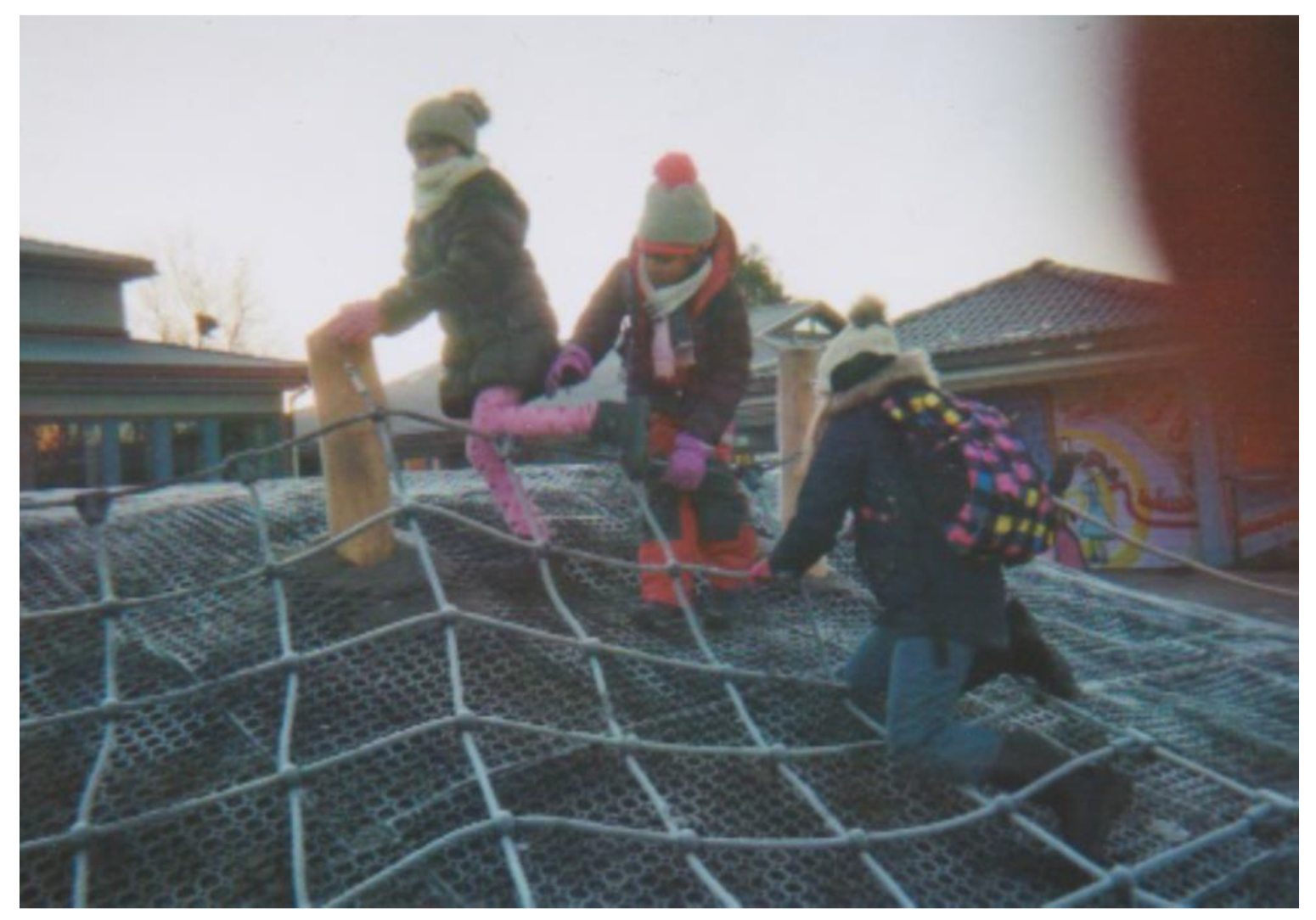
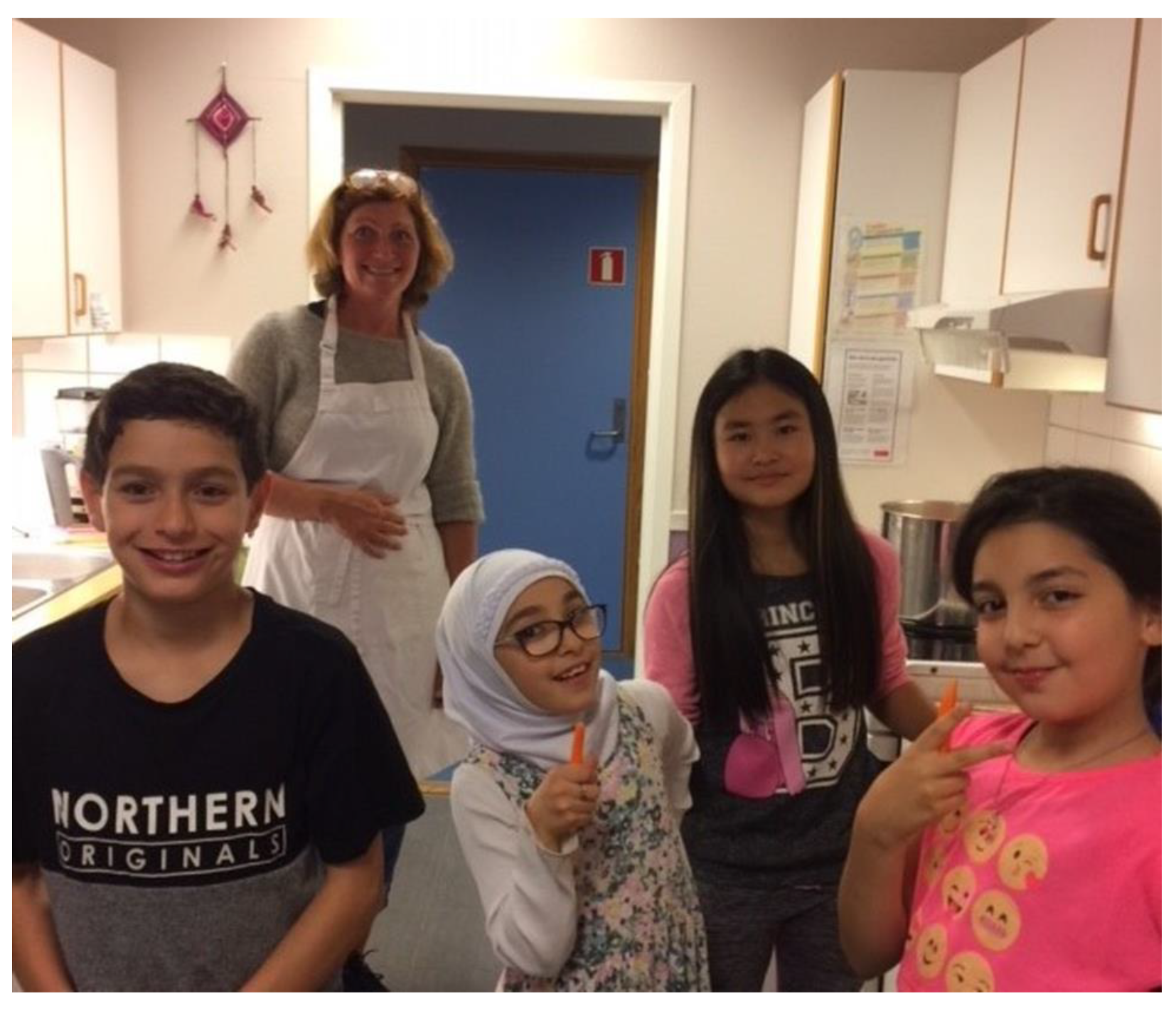
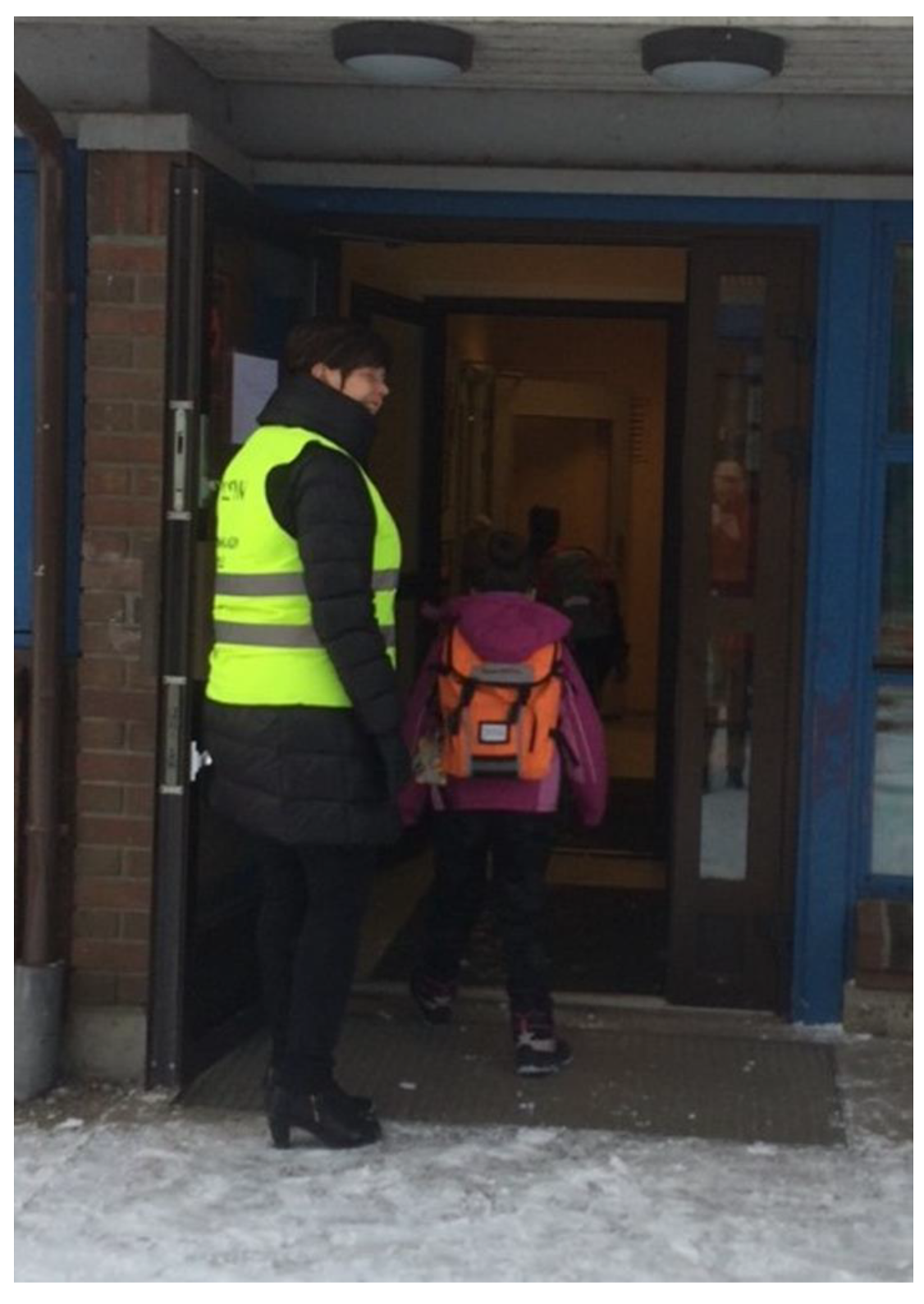
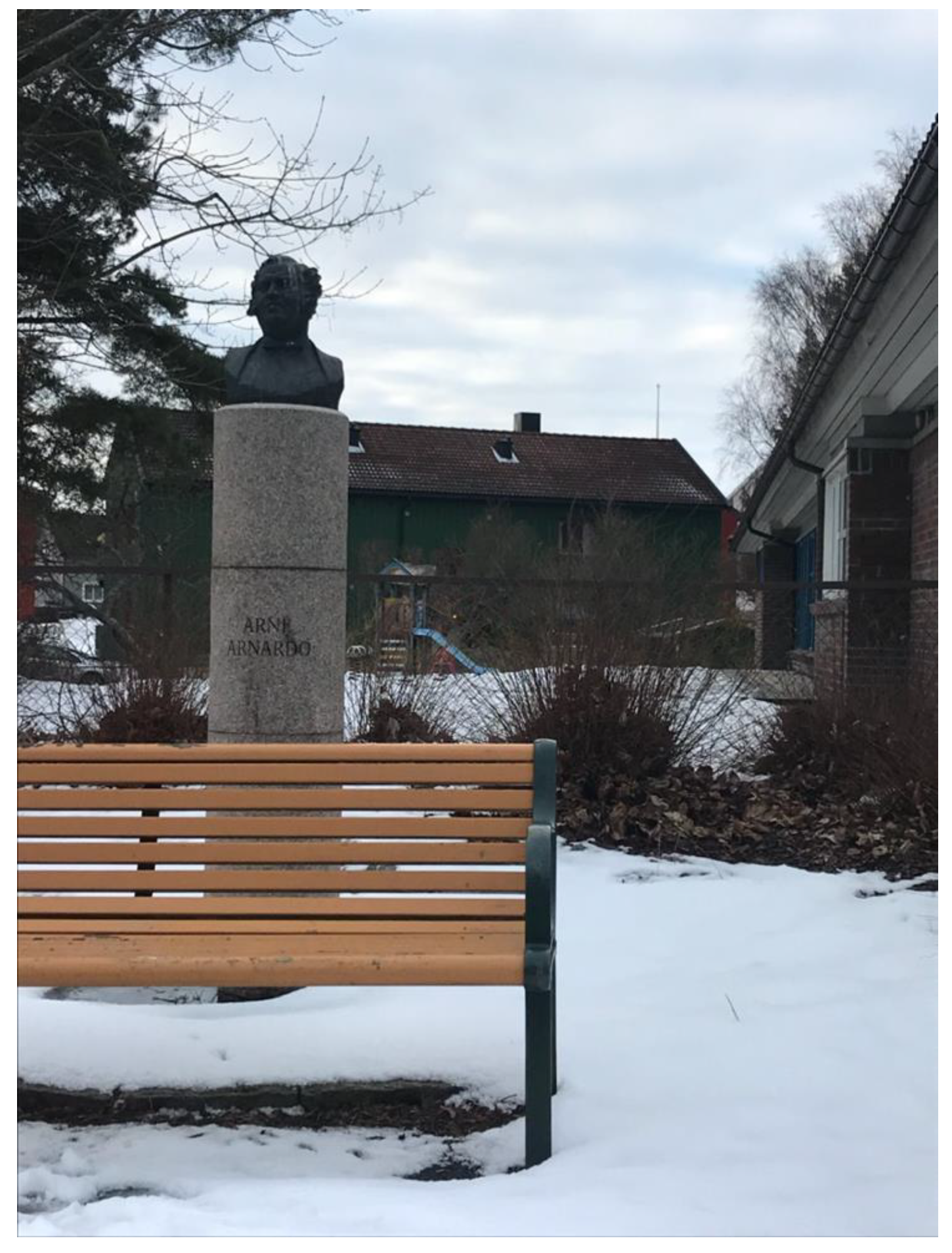
Publisher’s Note: MDPI stays neutral with regard to jurisdictional claims in published maps and institutional affiliations. |
© 2021 by the authors. Licensee MDPI, Basel, Switzerland. This article is an open access article distributed under the terms and conditions of the Creative Commons Attribution (CC BY) license (https://creativecommons.org/licenses/by/4.0/).
Share and Cite
Ihlebæk, C.; Castellan, C.; Flobak, J.; Ese, J. The School as an Arena for Co-Creating Participation, Equity, and Well-Being—A Photovoice Study from Norway. Int. J. Environ. Res. Public Health 2021, 18, 8252. https://doi.org/10.3390/ijerph18168252
Ihlebæk C, Castellan C, Flobak J, Ese J. The School as an Arena for Co-Creating Participation, Equity, and Well-Being—A Photovoice Study from Norway. International Journal of Environmental Research and Public Health. 2021; 18(16):8252. https://doi.org/10.3390/ijerph18168252
Chicago/Turabian StyleIhlebæk, Camilla, Camilla Castellan, Jenny Flobak, and Jo Ese. 2021. "The School as an Arena for Co-Creating Participation, Equity, and Well-Being—A Photovoice Study from Norway" International Journal of Environmental Research and Public Health 18, no. 16: 8252. https://doi.org/10.3390/ijerph18168252
APA StyleIhlebæk, C., Castellan, C., Flobak, J., & Ese, J. (2021). The School as an Arena for Co-Creating Participation, Equity, and Well-Being—A Photovoice Study from Norway. International Journal of Environmental Research and Public Health, 18(16), 8252. https://doi.org/10.3390/ijerph18168252





